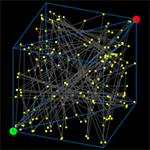Published/Posted: April 24, 2016
Authors: Sorrentino, F.; Pecora, L. M.; Hagerstrom, A. M.; Murphy, T. E.; Roy, R.
Abstract: Synchronization is an important and prevalent phenomenon in natural and engineered systems. In many dynamical networks, the coupling is balanced or adjusted to admit global synchronization, a condition called Laplacian coupling. Many networks exhibit incomplete synchronization, where two or more clusters of synchronization persist, and computational group theory has recently proved to be valuable in discovering these cluster states based on the topology of the network. In the important case of Laplacian coupling, additional synchronization patterns can exist that would not be predicted from the group theory analysis alone. Understanding how and when clusters form, merge, and persist is essential for understanding collective dynamics, synchronization, and failure mechanisms of complex networks such as electric power grids, distributed control networks, and autonomous swarming vehicles. We describe a method to find and analyze all of the possible cluster synchronization patterns in a Laplacian-coupled network, by applying methods of computational group theory to dynamically equivalent networks. We present a general technique to evaluate the stability of each of the dynamically valid cluster synchronization patterns. Our results are validated in an optoelectronic experiment on a five-node network that confirms the synchronization patterns predicted by the theory.Citation:
F. Sorrentino, L. M. Pecora, A. M. Hagerstrom, T. E. Murphy and R. Roy, "Complete characterization of the stability of cluster synchronization in complex dynamical networks", Sci. Adv. 2(4) e1501737 (2016)
Export: BibTeX | RIS
Manuscript: Sorrentino_SciAdv_2_e1501737_2016.pdf
Supplemental Files:
- Sorrentino_SciAdv_2_e1501737_2016_movieS1.mp4 - Supplemental Movie 1
- Sorrentino_SciAdv_2_e1501737_2016_movieS2.mp4 - Supplemental Movie 2
